Please visit Ryan Parton Writing Solutions, Comox Valley copy writer
Comox Valley Web Design
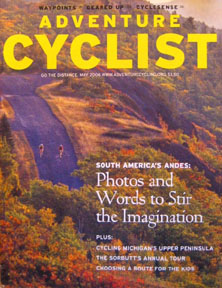 Cycling the Andes
Cycling the Andes
By Ryan Parton
Adventure Cyclist magazine, May 2006

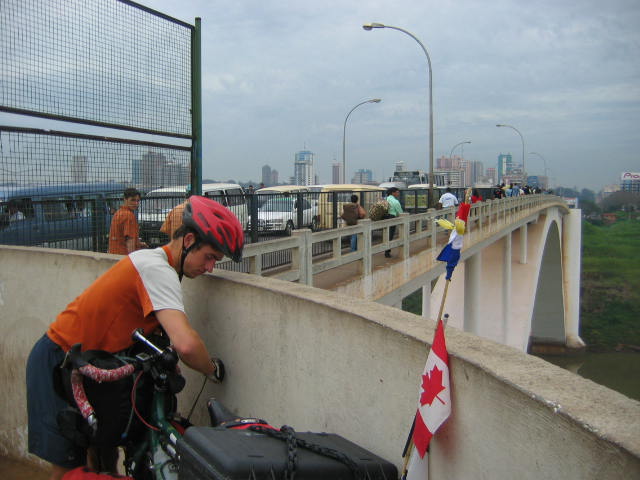 The bridge was a chaotic mess, a confusing tangle of timeworn cars, deafening two-stroke motorbikes and an endless stream of copper-skinned locals, their narrow backs laden with nondescript packages as cumbersome as small refrigerators. I felt conspicuous and vulnerable pushing my fully loaded Trek 4300 through this shifty mass of humanity, especially after all that I’d heard about the notorious swift-fingered opportunism of this particular corner of South America.
The bridge was a chaotic mess, a confusing tangle of timeworn cars, deafening two-stroke motorbikes and an endless stream of copper-skinned locals, their narrow backs laden with nondescript packages as cumbersome as small refrigerators. I felt conspicuous and vulnerable pushing my fully loaded Trek 4300 through this shifty mass of humanity, especially after all that I’d heard about the notorious swift-fingered opportunism of this particular corner of South America.
After several months of cycling up through South America’s southern cone, following in the tread marks of countless adventure cyclists before me along Chile’s renowned Carretera Austral and through the wind-ravaged wilds of Patagonia, I’d arrived in a part of the continent where tourism was virtually nonexistent. This was Paraguay, that country you once heard of in a sixth grade social studies class and then never heard of again. I was crossing into the unknown amidst a flurry of activity that was the perfectly antipodal beginning to a stage of my journey that would culminate on the high shores of a vast, silent lake ensconced deep in the Bolivian Andes.
I completed immigration formalities amidst a small crowd of curious shoeshine boys before pedalling off into the anarchy of Paraguay’s capital of contraband, Ciudad del Este. South America’s most bustling shopping center, Ciudad del Este is capitalism on Prozac, a sort of Paraguayan Tiajuana built on bootlegging and controlled by criminals, where you can find anything under the sun at rock bottom prices and never be asked to buy the extended warranty.
Paraguay’s only major highway stretches some 215 miles west from Ciudad del Este to Asunción, the country’s almost-modern capital. Although Paraguay’s finest road is a nice highway by South American standards, it left a bit to be desired from a cyclist’s viewpoint. The road’s five-foot wide shoulder should have provided ample solace from the cargo trucks thundering past just beyond my left handlebar, but any attempt to cycle along it was thwarted by the baseball bat sized speed bumps that spanned its width every 15 yards. I was forced to ride a fine line between an abrupt jolt from the booby-trapped shoulder and an even more abrupt one from the traffic on my left. The balancing act was made downright treacherous near a truck stop not far from Ciudad del Este where the pavement was coated with a slick layer of oil and grease from countless aging trucks, creating a deadly, slick-as-ice surface for about 20 miles.
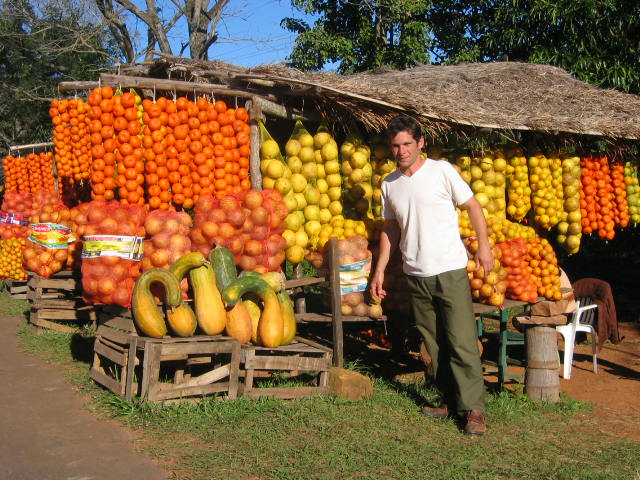 In the back of my mind, I worried that if the dangerous highway didn’t kill me, something else might. I’d been warned countless times to avoid Paraguay at all costs if I valued my life which, reportedly, would have no value to the soulless crooks who prowl this impoverished land. Indeed, one of the first things I noticed in Paraguay was a marked upgrade in security. Soldiers and police officers were positioned outside every bank or official-looking building, armed to the teeth with semiautomatic weapons half as large as they were and twice as old by the looks of most of the baby-faced sentinels. Nonetheless, the mayhem of Ciudad del Este notwithstanding, Paraguay’s tranquil countryside did much to ease my apprehensions.
In the back of my mind, I worried that if the dangerous highway didn’t kill me, something else might. I’d been warned countless times to avoid Paraguay at all costs if I valued my life which, reportedly, would have no value to the soulless crooks who prowl this impoverished land. Indeed, one of the first things I noticed in Paraguay was a marked upgrade in security. Soldiers and police officers were positioned outside every bank or official-looking building, armed to the teeth with semiautomatic weapons half as large as they were and twice as old by the looks of most of the baby-faced sentinels. Nonetheless, the mayhem of Ciudad del Este notwithstanding, Paraguay’s tranquil countryside did much to ease my apprehensions.
And then I was assaulted. Not by an angry mob or some petty thief, but by the dreaded triple beat of the cumbia, the aggressively repetitive “Ba ba bum, ba ba bum” that attacked me from every shop, home and rusted pick-up that I passed. Paraguayans like their cumbia, and they like it LOUD. When I sat down for lunch, one restaurant owner even raised the volume until the loathsome beat belched from the dusty speakers in a distorted roar that reverberated in my skull with all the musicality of a crying baby operating a jackhammer at an N’Sync concert.
Despite my musical differences with the Paraguayans, and although their country lacks the rugged mountain scenery and beautiful oceanside rides that attract cyclists to some other South American countries, Paraguay excels in at least one other area all-important to the touring cyclist - roadside snacks. The highway from Ciudad del Este to Asunción is lined with roadside fruit vendors and young girls in short skirts selling chipas, tasty bagel-like pastries made from manioc flour, eggs and cheese. After a tasty bite, I’d only have to ride another few miles for a chance to wash it down with an intensely sweet cup of mosto, a liquid energy rush made from juiced sugar cane that I swear made my brain vibrate. Not quite as appetizing was the strip of roadside butchers proudly displaying their fly-covered slabs of beef in the 80-degree sun.
My proud arrival in Asunción, one of the few South American capitals not ringed by sprawling slums, was unfortunately marred by tragedy. As I pedalled into town, a horrific supermarket fire had already claimed the lives of at least 300 people, a toll that would rise to more than 400 by the time I left three days later. A palpable sense of grief hung like a lead curtain in Asunción’s hot, dry air. National flags throughout the city were draped with black mourning sashes and hand-scrawled cardboard in shop windows declared “Closed due to mourning.” Although I would have enjoyed a longer stay in Asunción, I felt awkward lingering in a city struggling to come to terms with its worst tragedy in decades. With that in mind - and finding it much more appealing to bike down rather than up the Andes - I pedalled to the Asunción bus terminal and began a grueling four-day bus journey to Potosí, Bolivia which boldly reminded me why I generally choose to travel by bike.
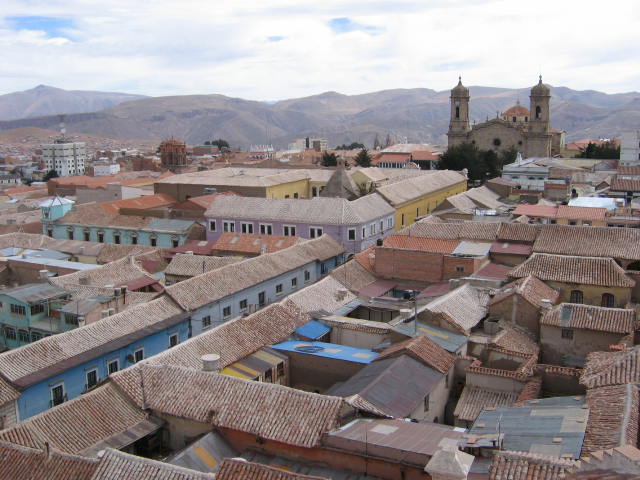 At an altitude of more than 13,000 feet, Potosí is the highest city of its size in the world. Although I planned to spend three days of rest acclimatizing to the rarefied air, I instead spent my time exploring the city’s crowded narrow streets and the abysmal working conditions of the nearby mines, the real reason Potosí exists at all.
At an altitude of more than 13,000 feet, Potosí is the highest city of its size in the world. Although I planned to spend three days of rest acclimatizing to the rarefied air, I instead spent my time exploring the city’s crowded narrow streets and the abysmal working conditions of the nearby mines, the real reason Potosí exists at all.
Perhaps it was because I spent my acclimatization time stooping around in dank mine shafts that I found myself in a state of near collapse halfway up my first Bolivian hill about 20 minutes out of the city. Leaning heavily on my handlebars, and gasping uncontrollably in spastic bursts, my lungs frantically tried to sate themselves on the thin Andean air. When my heart finally stopped pounding in my throat and I regained some semblance of composure, I scanned the stark beauty of the rugged landscape through which I was slowly passing. In all directions, the horizon rose and fell with the erratic contours of jagged peaks framed under a sky so blue you’d swear it had been digitally enhanced. Energized by the powerful serenity of my surroundings, I pushed on.
Although the cycling was tough, the rocky, winding road was a thrill ride in slow motion, at times clinging precariously to the edge of a blood-red canyon that reminded me of the one into which Wile E. Coyote repeatedly plummeted in the old roadrunner cartoons. A great day of riding culminated with an arduous climb the the top of a high pass, where I camped for the night under a fickle sky that alternately showed me stunning starscapes and flurries of light, driving snow. I don’t think I’ve ever felt so alone as I did that evening, and yet with the stars and mountains as my silent companions, I was never lonely.
Bolivia, sometimes referred to as the Tibet of the Americas, offers everything the bike tourist craves: wide open spaces, beautiful mountain scenery and plenty of opportunities to get well off the beaten path. The Bolivian paradox, however, is that the mountainous country is also rife with the things adventure cyclists loathe, like grueling climbs at oxygen-starved altitudes and roads so rough you wonder why you didn’t just stay at home, beat yourself in the ass with a paddle and save yourself the dust shower. In Bolivia, cycling off the beaten path often means cycling a path that’s going to beat you.
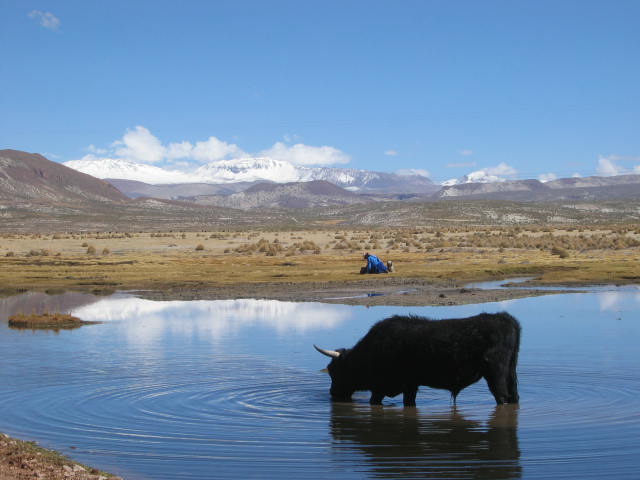 Past the tiny village of Tica Tica (where I was chased out of town by a trio of grubby children yelling, “Gringo!”) the road, already littered with fist-sized rocks, took a dramatic turn for the worse. It was the worst road surface I’d ever ridden, covered with the two most efficient momentum-suckers known to cyclists: sand and washboard. With my hands aching from the constant jolts and cursing loudly at whoever wasn’t around to listen, I managed to grind nearly 50 miles along this ugly road to the semi-abandoned mining town of Pulacayo, beautifully perched atop an outcrop of red rock speckled with hardy tufts of green alpine grass.
Past the tiny village of Tica Tica (where I was chased out of town by a trio of grubby children yelling, “Gringo!”) the road, already littered with fist-sized rocks, took a dramatic turn for the worse. It was the worst road surface I’d ever ridden, covered with the two most efficient momentum-suckers known to cyclists: sand and washboard. With my hands aching from the constant jolts and cursing loudly at whoever wasn’t around to listen, I managed to grind nearly 50 miles along this ugly road to the semi-abandoned mining town of Pulacayo, beautifully perched atop an outcrop of red rock speckled with hardy tufts of green alpine grass.
From Pulacayo it’s mostly downhill to Uyuni, a dust bowl of a town surrounded by tattered plastic bags and rusting heaps of scrap metal sitting on the edge of the Salar de Uyuni, the largest and, at 12,000 feet, highest salt flat in the world. As I intended to cross the Salar by bicycle, I ignored the myriad touts promoting 4 x 4 excursions and, after a night of relaxation and pizza, set out toward the great white expanse beckoning on the horizon.
The first stop before actually entering the Salar is the crumbling village of Colchani, about 12 miles north of Uyuni and home to about 150 people. With its deserted streets flanked by the ruins of abandoned clay homes and littered with forgotten trash, Colchani earned itself the unfortunate moniker of “Ugliest Town I’ve Ever Seen.” The Salar de Uyuni, in contrast, is surely one of the most amazing and unique places on the globe. The result of repeated evaporating and re-flooding of a massive ancient lake, the Salar de Uyuni is 4,800 square miles of flat, blindingly white salt - an estimated 10 billion tons of it - naturally arranged into a neat hexagonal grid that lends it an entirely otherworldly appearance. In the center of the Salar sits the absolutely surreal Isla Incahuasi, a rocky, cactus-studded “island” rising defiantly from the sea of white. Camping under a star-spangled sky in the shadows of Incahuasi’s towering cacti is an experience I won’t soon forget.
After crossing the Salar, heavy rains that made the already treacherous Bolivian roads virtually impassable forced another arduous bus ride to La Paz, the Bolivian capital. As I hoisted my bike onto the steel roof rack, I noticed that the driver was already wearing mechanic’s coveralls, my first clue that this bus may not have been the most reliable vessel. Nonetheless, I boarded the rickety vehicle for an unbearable 10-hour journey in the company of 10 passengers more than capacity, several dead and skinned pigs, a lamb in a llama wool sweater and one repetitive cumbia tape that sped up and slowed down at the rhythm of the struggling cassette player. We broke down four times and I couldn’t wait to get back on my bike.
I was joined in La Paz by Kris, an old high school friend who’d flown down from Canada to meet me. Together, we cycled west toward nearby Lake Titicaca despite warnings that the route would be blocked by striking transport drivers protesting rising fuel prices. We cycled through two small roadblocks without receiving so much as a second glance, but the third barricade looked like trouble. As we approached, a driver coming from the opposite direction was surrounded by about a dozen strikers who proceeded to haul him out of his truck, hold him horizontally and face-down in mid-air and lash his backside repeatedly with a rubber whip. The mob was still crowded on the highway when I cycled up, frantically trying to decide the best way to handle the volatile situation. Siding with the old adage, “If you can’t beat ‘em, join ‘em,” I cheered as loudly as I could as I entered the fray, wishing the strikers good luck and giving them all an exuberant thumbs up. The tactic worked, and instead of a beating Kris and I both received a spirited round of high-fives before cycling happily away.
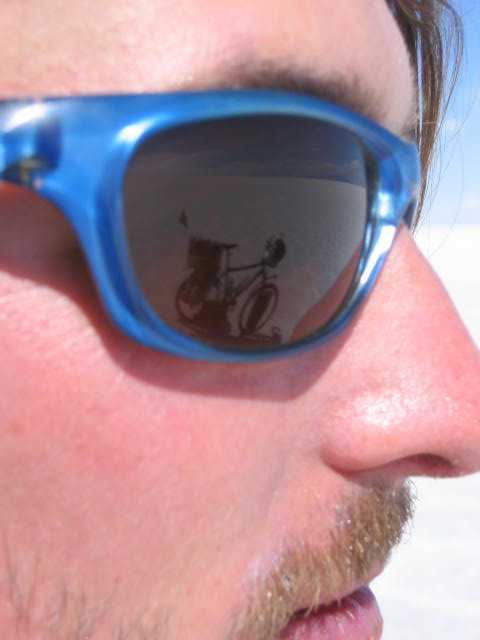 Our journey continued along the shores of Lake Titicaca, which sits at a lofty 12,500 feet and is considered the highest navigable lake in the world. It’s also South America’s second-largest and I frequently had to remind myself that the deep blue, island-pocked water shimmering under the Andean sun was not some beautiful forgotten corner of the Mediterranean.
Our journey continued along the shores of Lake Titicaca, which sits at a lofty 12,500 feet and is considered the highest navigable lake in the world. It’s also South America’s second-largest and I frequently had to remind myself that the deep blue, island-pocked water shimmering under the Andean sun was not some beautiful forgotten corner of the Mediterranean.
A white-knuckled descent into Copacabana, a small lakeside city crawling with sunburned European backpackers and enterprising local artisans hawking their wares from the sidewalks, signaled the end of this stage of my journey. As is often the case when an adventurous bike tour leads the rider into a tourist town, it was a bittersweet arrival. Although it was nice to check into a hostel and chat amiably with like-minded travellers, the novelty of clean towels and camaraderie quickly gave way to a renewed longing for the open road, and for the modest comfort of those seldom-visited locales where you’re seen as a fellow human being rather than a walking dollar sign.
Thus is the beauty of bike travel. Seeing the world from your saddle allows you to experience places that most tourists would never end up in and would complain loudly to their tour operators if they ever did. I’m talking about places like Jirira, Bolivia, where a kind family offered me their food, their home and their friendship despite my having arrived snappy and irritable after a failed attempt to cycle the mountain bike trail of a road out of town. Or Caaguazú, Paraguay, where the hospitality of some young volunteer firefighters far outweighed their deplorable taste in music. In South America’s two poorest countries, landlocked in the centre of an entire continent of more popular tourist destinations, I discovered a whole world of amazing people and places unknown to my travel agent and anyone who doesn’t travel by bike.
Back to Ryan's writing samples
 The bridge was a chaotic mess, a confusing tangle of timeworn cars, deafening two-stroke motorbikes and an endless stream of copper-skinned locals, their narrow backs laden with nondescript packages as cumbersome as small refrigerators. I felt conspicuous and vulnerable pushing my fully loaded Trek 4300 through this shifty mass of humanity, especially after all that I’d heard about the notorious swift-fingered opportunism of this particular corner of South America.
The bridge was a chaotic mess, a confusing tangle of timeworn cars, deafening two-stroke motorbikes and an endless stream of copper-skinned locals, their narrow backs laden with nondescript packages as cumbersome as small refrigerators. I felt conspicuous and vulnerable pushing my fully loaded Trek 4300 through this shifty mass of humanity, especially after all that I’d heard about the notorious swift-fingered opportunism of this particular corner of South America.  Cycling the Andes
Cycling the Andes In the back of my mind, I worried that if the dangerous highway didn’t kill me, something else might. I’d been warned countless times to avoid Paraguay at all costs if I valued my life which, reportedly, would have no value to the soulless crooks who prowl this impoverished land. Indeed, one of the first things I noticed in Paraguay was a marked upgrade in security. Soldiers and police officers were positioned outside every bank or official-looking building, armed to the teeth with semiautomatic weapons half as large as they were and twice as old by the looks of most of the baby-faced sentinels. Nonetheless, the mayhem of Ciudad del Este notwithstanding, Paraguay’s tranquil countryside did much to ease my apprehensions.
In the back of my mind, I worried that if the dangerous highway didn’t kill me, something else might. I’d been warned countless times to avoid Paraguay at all costs if I valued my life which, reportedly, would have no value to the soulless crooks who prowl this impoverished land. Indeed, one of the first things I noticed in Paraguay was a marked upgrade in security. Soldiers and police officers were positioned outside every bank or official-looking building, armed to the teeth with semiautomatic weapons half as large as they were and twice as old by the looks of most of the baby-faced sentinels. Nonetheless, the mayhem of Ciudad del Este notwithstanding, Paraguay’s tranquil countryside did much to ease my apprehensions. At an altitude of more than 13,000 feet, Potosí is the highest city of its size in the world. Although I planned to spend three days of rest acclimatizing to the rarefied air, I instead spent my time exploring the city’s crowded narrow streets and the abysmal working conditions of the nearby mines, the real reason Potosí exists at all.
At an altitude of more than 13,000 feet, Potosí is the highest city of its size in the world. Although I planned to spend three days of rest acclimatizing to the rarefied air, I instead spent my time exploring the city’s crowded narrow streets and the abysmal working conditions of the nearby mines, the real reason Potosí exists at all. Past the tiny village of Tica Tica (where I was chased out of town by a trio of grubby children yelling, “Gringo!”) the road, already littered with fist-sized rocks, took a dramatic turn for the worse. It was the worst road surface I’d ever ridden, covered with the two most efficient momentum-suckers known to cyclists: sand and washboard. With my hands aching from the constant jolts and cursing loudly at whoever wasn’t around to listen, I managed to grind nearly 50 miles along this ugly road to the semi-abandoned mining town of Pulacayo, beautifully perched atop an outcrop of red rock speckled with hardy tufts of green alpine grass.
Past the tiny village of Tica Tica (where I was chased out of town by a trio of grubby children yelling, “Gringo!”) the road, already littered with fist-sized rocks, took a dramatic turn for the worse. It was the worst road surface I’d ever ridden, covered with the two most efficient momentum-suckers known to cyclists: sand and washboard. With my hands aching from the constant jolts and cursing loudly at whoever wasn’t around to listen, I managed to grind nearly 50 miles along this ugly road to the semi-abandoned mining town of Pulacayo, beautifully perched atop an outcrop of red rock speckled with hardy tufts of green alpine grass.  Our journey continued along the shores of Lake Titicaca, which sits at a lofty 12,500 feet and is considered the highest navigable lake in the world. It’s also South America’s second-largest and I frequently had to remind myself that the deep blue, island-pocked water shimmering under the Andean sun was not some beautiful forgotten corner of the Mediterranean.
Our journey continued along the shores of Lake Titicaca, which sits at a lofty 12,500 feet and is considered the highest navigable lake in the world. It’s also South America’s second-largest and I frequently had to remind myself that the deep blue, island-pocked water shimmering under the Andean sun was not some beautiful forgotten corner of the Mediterranean.